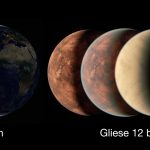Key Takeaways:
- Astronomers have discovered a black hole nicknamed “The Unicorn” which is both the closest black hole to Earth and the smallest black hole ever detected.
- The Unicorn is 1,500 light-years from Earth and has 3 times the mass of the Sun.
- The previous closest black hole was twice as far away as the Unicorn and the smallest black hole record holder was 3.3 solar masses.
- Astronomers discovered the Unicorn by observing the way it affects its companion star.
- The researchers predict that more black holes in this mass gap may be found in the coming years.
Astronomers have discovered a black hole that may set a new record or two – it seems to be both the smallest black hole ever detected, and the closest one to Earth found so far.
The black hole, known by the nickname “The Unicorn,” is situated in the constellation of Monoceros directly next to the red giant star V723 Mon. At a mere distance of 1,500 light-years from Earth, the object’s mass seems to be only three times that of the Sun.
Those are both potential black hole records. The previous closest black hole was twice as far away as the Unicorn, while the smallest black hole record holder was 3.3 solar masses. The latter record is a little contentious, however – last year it was proposed that the star system HR 6819 housed the closest known black hole, just 1,120 light-years away, but follow-up studies throw doubt on there being a black hole there at all.
In any case, the unicorn is still a fascinating oddity. It is smaller than the majority of stellar mass black holes, which are the smallest black holes. They are classified as having between five and 30 solar masses. Astronomers didn’t really believe they came any smaller than that until recently.
Naturally, black holes are difficult to see due to their nature. Rather, the unicorn was discovered by astronomers as a result of its effects on its companion star. Its light seemed to be changing in intensity at different times during its orbit, indicating that something close was stretching it into an unusual shape. Since it didn’t have a visible star buddy, a black hole seemed to be the most likely candidate.
Todd Thompson, a co-author of the study, says that the black hole “distorts the star into a football-like shape with one axis longer than the other, just as the moon’s gravity distorts the Earth’s oceans, causing the seas to bulge toward and away from the moon, producing high tides.” “The simplest explanation is that it’s a black hole – and in this case, the simplest explanation is the most likely one.”
Through the examination of the star’s velocity, circular period, and gravitational distortion, the astronomers determined that the black hole held three times the mass of the Sun.
The researchers predict that as telescopes get more powerful and astronomers become better at data analysis, more black holes in this mass gap may be found in the coming years.
The research was published in the journal Monthly Notices of the Royal Astronomical Society.


